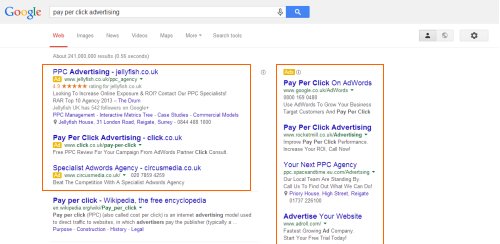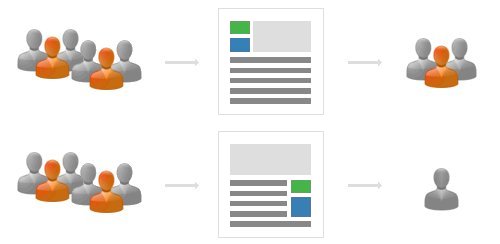The Bad Old Days Of Online Advertising
It used to be that online advertising was synonymous with untargeted banner ads or pop-ups. Because of their untargeted nature, these were paid for per thousand views and were usually of little relevance to the user. In some cases, advertisers were primarily concerned with brand awareness, but these campaigns performed very poorly in terms of the number of people that clicked on such ads. The overall image of online advertising therefore became one of high cost and little return - a world reserved for global brands.
The New World
The birth of Google Ads produced a seismic shift in the online advertising world. Suddenly, advertisers only had to pay for clicks (not views) and this made online advertising possible with any budget. With the accompanying improvements in technology and self-service software, small businesses could also begin to track exactly what people who clicked on their ads went on to do on their website (e.g. make a purchase). The beauty of this is that any small business can now spend a few hundred dollars on Pay-Per-Click (PPC) Advertising, either through Google Ads, Bing Ads, Facebook Ads or others, and subsequently work out exactly what they must spend in advertising to generate a sale.

How Pay-Per-Click (PPC) Programs Work
As a simplistic overview, the cost to advertise with most PPC programs depends on the market - they usually operate in the style of an auction where the advertisers willing to pay most per click will be promoted the most. An advertiser will select what keywords they want their ads associated with - for example, if a company sells digital radios they would want their ads to be displayed when someone searches for "digital radios". An advertiser will then decide the maximum they would like to spend per click, as well as a maximum daily budget if they would like to spread the cost of the campaign. If other advertisers are willing to spend $4 per click and a company only wants to spend $2 per click, their ads will rarely be seen, if ever. However, even if a company opts to spend more than any other competitor on clicks, their ad will only be promoted if it has a reasonable "quality score". For example, if that same company's ads contained text related to televisions instead of radios, it is unlikely that anyone searching for "digital radios" would click on them. From the program's point of view it is therefore not in their interests to promote such ads, since no payment per click would be generated.
Using Website Analytics, a company advertising with a PPC program will be able to see the activity of each user who clicked once they reached their website. In addition, Google Ads allows for the tracking of any actions (or "conversions") taken by users who clicked - such as making a purchase or using a contact form. This means that any advertiser can at any time see how much they have spent, how many clicks they received, and how many of those clicks resulted in a sale or a lead. That is, the advertiser can work out their average Cost Per Click (CPC) and subsequent Cost Per Acquisition (CPA).
A Basic Pay-Per-Click (PPC) Example
As an example, let's say that a company sells Product A for $499 with a $200 profit margin (when marketing costs are excluded) and that company decides to spend $900 on PPC advertising. It is immediately obvious that the company would have to make five sales to cover their advertising costs for this campaign. In this example, let's say that the market for Product A dictates that the company will need to pay $6 per click to achieve a reasonable number of clicks per day, and the company sets a daily budget limit of $60. The company finds that each week they spend approximately $420 and receive approximately 70 clicks on their ads. When the company's $900 budget has been exhausted they have received approximately 150 clicks and notice that in their Google Ads control panel that 6 of those clicks have been converted into sales.
From these statistics, the company can calculate that their CPA (the amount of ad-spend required to generate a customer) is $150, resulting in a $50 profit for each sale made via the PPC program they are using. Armed with this knowledge, the company decides to spend $2700 on PPC advertising the following month, resulting in 15 new customers and $750 profit.
A More Complex Pay-Per-Click (PPC) Example
In the above example, the resulting CPA happens to match the Return on Investment (ROI). But even in this simple example, the CPA calculated does not take into account the fact that buyers may return to the company's website in the future to make additional purchases (the "lifetime value") - resulting in a higher ROI than the initial figures indicate. And, of course, many websites act only as a lead-generator for making sales offline, so PPC campaigns for these websites are more difficult to quantify. However, if lead generation is tracked as a "conversion", ROI can be calculated as long as the number of leads that convert to sales is known. For example, if an accountancy company receives 6 new leads (people who use their contact form) per 150 clicks, and two of those leads become customers, it is relatively simply to calculate their campaign's ROI.
The Importance of Optimizing Your Website
Too many PPC advertisers concentrate only on their ads and the number of clicks they are generating. But possibly the single most important factor in reducing your CPA and increasing your ROI is the quality of your website as a sales tool. On average, only between 1% and 3% of the people who clicked an ad will be "converted" (regardless of whether a conversion represents a sale or a lead generation) - a figure that is always disappointing and somewhat confusing to most new advertisers. If you consider the difference in ROI between 1% of clicks becoming customers and 3% of them becoming customers, it is of paramount importance that your website is effective in "converting" clicks for you. It is therefore common to "split-test" Google Ads campaigns so that different ads go to different pages of your website ("landing pages"),each designed slightly differently. After several hundred clicks on your ads, some of your landing pages may be found to be converting more clicks into customers than other landing pages - meaning that you can start sending all clicks to the best one and reduce your CPA.

Making a purchase or inquiring about a service is a big step for a website visitor, especially when a website is new to them. Many websites increase their ROI from PPC campaigns by offering visitors a "soft" alternative to taking that big step. For example, as well as allowing visitors to commit to a product or service, a website could offer visitors a compelling offer, such as a free report or discount code, that a visitor can receive by email. This is not likely to decrease the number of visitors that make a purchase, but it is likely to increase the number of leads that the website receives from the campaign. Naturally, some of these "soft" leads will eventually become customers if the website reaches out to them with, for example, their email newsletter - a systematic approach that is often referred to as a "sales funnel". Both types of lead can be differentiated as different kinds of conversion in Google Ads, and in the long-term the number of "soft" leads that get converted to customers can be added to ROI calculations.
Conclusion
The beauty of Pay-Per-Click (PPC) Advertising when compared to traditional advertising such as print media should be clear - advertisers know exactly how much each new customer has cost them. And once an advertiser knows their average CPA, they can plan how many sales or leads they want to generate per month, and moderate their advertising spend accordingly.